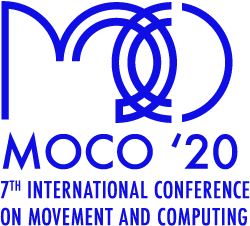Detailed SESSION INFORMATION
JULY 16,2020: 1:30-3 PM EDT (UTC -4)
Spheres a Dance for Virtual Reality
Sarah Neville
ABSTRACT
+
Spheres a Dance for Virtual Reality demonstrates how it feels to dance in immersive
digital environments. This research is part of a more expansive research focus on how
dance knowledge/ embodied knowledge is transferred and transmitted in immersive
digital environments. The application was constructed with the aim for the participant
to interact with the work and experience contemporary dance first hand. The
experience involves moving with the dancers, moving the dancers and being moved by
the dancers. To develop the choreographic design for Spheres a Dance for Virtual Reality,
we work-shopped possible simulation scenarios considering the potential of the game
engine software along with a choreographic vision and the potential hopes and fears for
the participant. Transmission of embodied knowledge/ dance knowledge in Spheres a
Dance for Virtual Reality is passed on through the development of emergent
choreographic languages such as wayfinding, guided movement and digital kinship.
PHOTO & VIDEO
Still taken from Spheres a Dance for Virtual Reality – Giants section
Can you say something?
Mimi Yin, Tiri Kananuruk and Nini Dongnier
ABSTRACT
+
Hello?
Are you there?
Can you see me?
Can you hear me?
Can you say...something?
This is our daily refrain as we log on to meet disembodied face to disembodied face.
Now that it is harder for me to understand you, do I pay closer attention?
Now that you have been reduced to a portrait of yourself, I find myself looking at your face with
unrestrained attentiveness. I stare without your awareness censoring my gaze. I look for invisible signs of something, I don’t know what.
Can you say something? is the second in a series of meditations on the illusion that is
communicating online. It magnifies the glitching, dropped frames and delay that delete the
subtle nuances of human expression and then asks the audience to lean in and pay closer
attention in order to understand.
PHOTO & VIDEO
Why Should Our Bodies End at the Skin?
Aurie Hsu and Steven Kemper
ABSTRACT
+
Why Should Our Bodies End at the Skin? for sensor-equipped dancer, robotic percussion, sound
exciters, and live sound processing, explores questions of fluidity between organism and
machine as raised in Donna Haraway’s 1984 essay “A Cyborg Manifesto.” This fluidity creates
hybrid bodies and explores embodiment in our techno-culture where the lines between organism
and machine become indistinguishable in a “joint kinship.” The piece realizes the hybrid body in
performance, sonically connecting mechanized human movement and humanized robotic action.
The robotic percussion serves as a visual and sonic extension of the dancer’s body. The RAKS
(Remote electroAcoustic Kinesthetic Sensing) system, a wireless wearable sensor interface,
translates the dancer’s movement into activations of the robotic percussion instrument CADI
(Configurable Automatic Percussion Instrument). Through the RAKS system, the dancer also
controls computer-generated sound processing and synthesis. Why Should Our Bodies End at the
Skin? was commissioned by the Ammerman Center for Arts and Technology.
PHOTO & VIDEO
Aurie Hsu and Steven Kemper performing Why Should Our Bodies End at the Skin? at the Ammerman Center for Arts and Technology 16th Biennial Symposium. Credit: Jack Beal
«Tanzseil»
Lisa Mark and Mira Studer
ABSTRACT
+
The body marks the center, the center moves through space.
Although there is only one single point of contact with the wire you can hear the entirety of
all interacting body parts.
The guiding principle of Tanzseil is an inverted tightrope dance. The rope is not tensioned
under the dancer, but above her.
Compared to contemporary dance practices, where movement is often perceived through
the relation of the feet to the floor, here the upward relation to the other end of the body,
the head, is added. It enhances the awareness of the position of the head in each movement
at all times.
The dancer moves to the sound of the wire rope acting as a string, which she generates
herself through her movements.
Compared to an instrument, the dancer moves through the room as a human bridge, so to
speak. The movement in space can be experienced kinesthetically and auditory in a very
direct way.
PHOTO & VIDEO
Tanzseil, HKB Playtime Festival Bern, January 2020. Credits: Stephan Wermuth
Additional Material 1, Material 2, Material 3
OUTPUT: Vestiges of Human and Robot Bodies
Catie Cuan
ABSTRACT
+
OUTPUT is a collaboration between a dancer/choreographer, roboticists,
software engineers, and filmmakers, developed over the course of an artist residency at
software engineering company ThoughtWorks. The result is a live performance, two
custom software programs, a short film, an improvisational structure, and an artistic
methodology for choreographing robots. The “original” bodies are that of a dancer and
ABB IRB 6700 massive industrial robot named the “Wen”. The motions of a dancer and
Wen are collapsed from 3D into 2D video, animation, and Kinect depth sensor data,
revealing the biases and limitations of each representation. In performance, the software
programs run livetime on laptops which are projected onto screens. The performer
improvises with these programs like musical instruments - a practice bridging
computation, improvisation, and dance - and embodying the process of “being inside the
machine”.
PHOTO & VIDEO
OUTPUT in performance at Triskelion Arts, Greenpoint, Brooklyn, in September, 2018. Performer Catie Cuan does a dance improvisation in front of a Kinect v2 to populate her captured human skeleton in upstage right. The captured skeleton is shown next to an animation of an industrial robot with the software CONCAT. She wields a wireless mouse and webcam to simultaneously operate the video-stitching software MOSAIC, forming the moving collage at center upstage.





